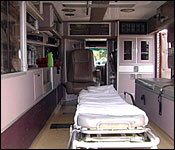
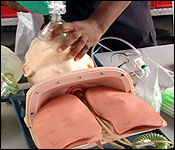
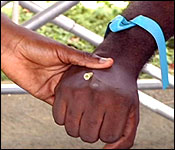 When we hear those ambulances screeching down the road - we don't give much thought to the training and preparation that the crew inside the ambulance must have.
When we hear those ambulances screeching down the road - we don't give much thought to the training and preparation that the crew inside the ambulance must have.
But, if you ever have to be ferried in an ambulance, you'll know that every decision that they make can mean the difference between life and death.
And that's why BERT- the Belize Emergency Rescue Team held an open day today - to showcase their training and service. Monica Bodden visited and seems to have been impressed:..
Monica Bodden reporting
Inside the parking lot at the Belize Emergency Response Team's office was their Open Day - where paramedics held huge displays to showcase what they do on a daily basis.
There was a wealth of information offered to the public - and even live demonstrations on how they respond to emergencies of all types.
Yvette Burke - Director of B.E.R.T
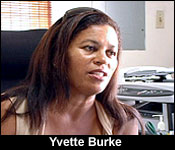 "Monica we are doing a little open day affair which was organized by our training department and I applaud them for doing it because I think frequently people forget what is the importance of having a qualified medical emergency response available to the city and district of Belize and a few places in the rest of the country but hopefully eventually the rest of the country does make a difference, so I hope that our people were able to show you some of the stations and understand some of what we are trained to do and what we do when we respond to emergencies of all types."
"Monica we are doing a little open day affair which was organized by our training department and I applaud them for doing it because I think frequently people forget what is the importance of having a qualified medical emergency response available to the city and district of Belize and a few places in the rest of the country but hopefully eventually the rest of the country does make a difference, so I hope that our people were able to show you some of the stations and understand some of what we are trained to do and what we do when we respond to emergencies of all types."
Leon Segura - Emergency Medical Technician
"We are going to pull out a few equipment and show you how we work. For instance we have some necessary equipment; this is a Pulse Oximeter and this is going to be one of the first things you would see; most medics place it on a patient finger and that pretty much tell us your oxygen saturation in your blood and with that we would know what level of necessary treatment we are going to give - oxygen is the first line of drugs that normally is provided for any patient that we meet."
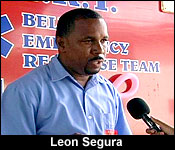 "We have the basic nasal cannula which is placed in the patient nose and it is connected to the oxygen which runs about 2-6 liters of oxygen per minute or we could take it up a notch to another rebreather mask - this gives 100% oxygen to the patient and this is connected to the oxygen at 15 liters."
"We have the basic nasal cannula which is placed in the patient nose and it is connected to the oxygen which runs about 2-6 liters of oxygen per minute or we could take it up a notch to another rebreather mask - this gives 100% oxygen to the patient and this is connected to the oxygen at 15 liters."
"In the event that you have patients that may - let's say that this is a healthy patient and he has no airway compromise, you are going to find out that's its quite easy to get air in the lungs. Now you could find a patient over here - if you look at that lung - very minimal movement. That doesn't mean that this patient don't need the same amount of oxygen that one is having. That's where we have advance life care - the indicator tube or the LMA or the King's tube. This is considered to be the primary airway management for any patient. Even if we used these it would only be temporary, maximum of about 24 hours but at the end of the day this is going to be the primary ones."
And while Segura is responsible for airway management of the human body, that is just one aspect when responding to an emergency.
Carla Flowers - Paramedic
"Now Mr. Petzold - he and I will a demonstration. What I do is first of all we have to do BSR - we have to put on our gloves to protect from any fluids because of HIV or Hepatitis - we don't want to get it."
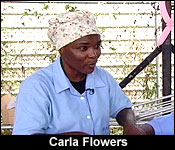 "First what we do is lock off the vein so that we can see where we are going to prick the person hand the veins start to swell, as you can see it starts to swell here already; we get our alcohol swab and we wipe the area in a circular motion to clean the area and we start with prick the person hand. We go a 45 angle degree - as you can see the blood already come in. What we do, we do not leave the needle in - this plastic core as you can see here - we thread it in and then we clamp the Teflon that is in and we pull out the needle - this is the needle that we disregard and then we get the line and we attach it here."
"First what we do is lock off the vein so that we can see where we are going to prick the person hand the veins start to swell, as you can see it starts to swell here already; we get our alcohol swab and we wipe the area in a circular motion to clean the area and we start with prick the person hand. We go a 45 angle degree - as you can see the blood already come in. What we do, we do not leave the needle in - this plastic core as you can see here - we thread it in and then we clamp the Teflon that is in and we pull out the needle - this is the needle that we disregard and then we get the line and we attach it here."
As these demonstrations show - the job of a paramedic is a huge load- since they are responsible for saving lives.
And so, they must undergo hundreds of hours of intense training for the year - at least 1 workshop every 2 weeks.
Yvette Burke - Director of B.E.R.T
"Anybody who is an emergency medical technician has to complete quite a rigorous little schedule and we are still doing it in a crash course format mostly in Belize. Essentially they have to have about 180 classroom contact hours I don't know if they shared the text with you but it is quite an extensive text and so this is just to get a certificate because you get a certificate does not make you a medic meaning that you can practice because you still have to be able to acquire a license."
BERT Ambulance operates within 36 miles out of the city on the Western and Northern Highway and once a person is being transported to the KHMH - there are no charges for their services.
Yvette Burke - Director of B.E.R.T
"From where I sit the multipart message I want to get across to people is we are subsidized by the government to an extent and that allows us to take patients from a true emergency situation to the Karl Heusner Memorial Hospital which is the default hospital for free. Patients do not have to be afraid to call us - family should call us. Don't worry if you are going to Karl Heusner and somebody is having a diabetic crisis, heart attack, they been in an accident or any sort, whatever the vase may be please call us. That's what we are here for. We will come to you as fast as we possibly can."
BERT operates as far as 36 miles out of the city on the Western and Northern Highways and once a person is being transported to the KHMH - there are no charges for their services.



